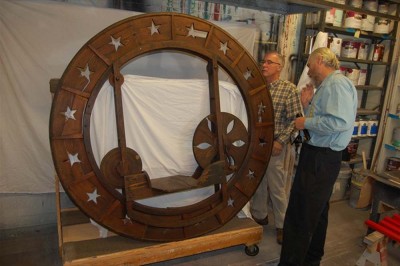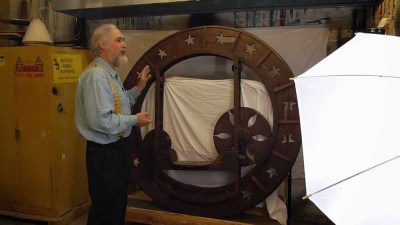Bill’s Amazing Project
Wrapping up my business in Cedar Rapids with the successful connections for fabricators and lighting folks and printers, i parted ways with the beloved Abraham clan. Since I was already in the Midwest, and since Wisconsin is right next door to Iowa, I decided to pop up to Green Bay and visit my dear friend a colleague Bill Robillard, furniture preservation practitioner extraordinaire.
Bill is just starting a conservation project on an amazing artifact, which is sort of a cross between a velocipede and a teeter totter. We’ve been corresponding about this project, and he thought it would really help for me to chat with the staff of the museum to help him outline the strategy.
I’ve included the article from a local news outlet, and you can see some video from the local station here.
Reposted from http://www.wearegreenbay.com/story/d/story/critic-at-large/80761/Fwap4Iqy1Ua9xmJZP0_DhA
PHOTO: Conservators William Robillard, rear, and Don Williams examine a 19th-century monowheel Wednesday at theNeville Public Museum in Green Bay. Warren Gerds photo
GREEN BAY, Wis. (WFRV) – A person would ride the object in the photograph. With hand power. The thing weighs around 100 pounds. It’s one of a kind. Hand made. Wood and iron. The thing is called a monowheel. It may have been made by someone from the Green Bay area. The object dates to the 19th century, maybe as early as 1869. The monowheel is about to head out on a big trip. In preparation, it is getting a new lease on life – restoration.
Through the end of the year, William Robillard, a restorer/conservator who resides in the Green Bay area, will spend hundreds of hours with his nose to the wheel at the Neville Public Museum of Brown County in Green Bay as he rejuvenates the piece. The monowheel will be on display through 2015 at the Wisconsin Historical Society in Madisonand the History Museum at the Castle in Appleton.
The object received extra attention Wednesday, when prominent conservator Don Williams stopped in briefly to examine the piece and put his head together with Robillard about fine points of the restoration.
Prior to retirement, Williams was senior furniture conservator at the Smithsonian Institution’s Center for Materials Research and Education near Washington D.C. He worked on many objects in the “nation’s attic” – the Smithsonian.
Robillard said, “Don Williams is my mentor and a dear friend. Don is in the area, and I asked him to stop in and give his advice on the project.”
Williams later kidded about being “in the area” but was clear about being enticed by the monowheel. How many has he seen? Answer: “Counting this one, it makes exactly one.”
The monowheel is owned by the Neville Public Museum.
“It’s part of our permanent collection,” said Louise Pfotenhauer, curator of collections. “It has been on exhibit in ‘Edge of theInland Sea’ for many years, and we’re taking it off (because of the loans).”
The monocycle has been at the museum since 1943, Pfotenhauer said.
“It was donated by Frank Duchateau, who was a major donor,” she said. “He gave us over 11,000 objects total.”
What’s the monowheel worth?
Pfotenhauer: “I can’t speak to value exactly, but, you know, there’s a collector for everything and the fact that it is a rare piece, of course, would make it more valuable.”
Robillard, who owns Encore Restorations, has worked in the past with the museum and Williams. In 2013, Robillard helped restore the dais of the U.S. House of Representatives. A feature on that is athttp://www.wearegreenbay.com/1fulltext-news/warren-gerdscritic-at-large-restorer-savors-reviving-us-house-grandeur/d/1fulltext-news/Y7-YBX218U-LIQKyf3Vg8w.
The monowheel has signs of being used. There is wear on the seat and the hand crank handle.
Robillard said, “I would define wear not so much as use but wear more in terms of its interaction with the environment and what’s happening. From that perspective, it’s wearing very quickly.”
Robillard gave a quick once-over report:
“If you look at the monowheel, it’s cracked around the periphery. This is very typical of oaks or ash woods. They tend to expand and contract and develop these cracks. We’d like to have the monowheel around for generations to come, and the way to do that is preserve it, put a coating around it – something like an M&M, if you will – that will protect the artifact now and into the future. The key to doing that is to do it properly. We don’t want to in any way impact the natural patina, so it’s really a lot of chemistry around how to create this M&M shell that protects it but does not cosmetically change it.”
The monowheel is one of a kind.
Robillard: “As you work through the artifact, you can tell this is a labor of love. This is all hand-crafted. Each panel is unique and hand-cut and on and on. It was put together with hide glue, which would have been used at that time, and decorated with some plant-resin paints, and you can just see the residue as well. It’s very much one of a kind.”
The monowheel is 67 inches in diameter. The woods are likely red oak and ash, Robillard said.
Robillard: “A fairly skilled woodworker would have built this piece. Not only are there the obvious cut-outs with the stars, but you see some bent laminations or bent wood. This would have taken many hours to build – a labor of love. They would have had to known something about steam bending and hand planning, etc., so they would have been a skilled woodworker, or woodworkers.”
The thing looks heavy.
Robillard: “It’s wood and iron band inside and out, so it’s relatively heavy. I would say we’re in the 100-pound area. Dedication. This is a labor of love, to build it AND to use it.”
Robillard supplied some imagination: “I think one sits in the seat and hand pedals. Perhaps you could use your feet but likely (you power it) with your hands, and the outer donut rotates around the cycler. One can envision a parade. Maybe it’s the Fourth of July. Let’s imagine this painted up with red, white and blue and somebody going through the street cycling this bike. That would have been quite an attraction.”
Williams and Robillard perused the piece in detail. They looked at it from every which angle. Nooks, crannies, cracks. Williams shone a flashlight in dark corners and crevices.
Williams said he saw some red flags – “Only because there are so many pieces. Literally, there are so many different pieces and elements of this, and a fair bit of attention has to be paid to all of the end grain of the wood because that’s where wood absorbs and desorbs moisture the most effectively. So Bill’s going to have to be very attentive. You see all the cut-outs and stars – all of those surfaces are going to need to be encapsulated and sealed from moisture exchange, because that’s the enemy of this thing. Moisture fluctuation is the enemy of this artifact… Once those moisture margins have been sealed – as long as it’s handled with careful thought – there’s no reason this can’t last centuries yet to come.”
A conversation with Don Williams swiftly turned colorful and humorous.
“Bill brought me to Green Bay. I’m putting together an exhibit in Cedar Rapids, Iowa. Since I was coming from the East Coast – you know, Cedar Rapids and Green Bay, they’re like right next door to each other – so I just popped on up yesterday (Tuesday). Bill had shown me pictures of this before, and it was really fascinating. In Cedar Rapids next May, I am doing an exhibit of perhaps the most famous toolbox+ in American history. Bill is going to be one of the people who is going to help me put the exhibit together physically on the ground there in Cedar Rapids. So that’s the connection. He was visiting me in my home last month and showed me pictures of this, and I said, ‘Well, you know, I’m only going to be one state away, maybe I should just come up.’ So I’m here for about an hour, and I have to head back to other appointments down south later today.”
The uniqueness of the monowheel attracted Williams.
Williams: “Bill and I were talking last night about the kind of projects I like to do, and they involve either really unusual objects or objects that have unusual problems. I’m not especially attracted to what I would call lifestyle of the rich and famous artifacts but objects that have really complex technical problems or were complex in their making. Those really get my headlights on high beam. And this is, indeed, a compound-complex object with some pretty serious issues to attend to. It’s actually in remarkably good shape given what it is and its history, but it is a very complex artifact made of hundreds of pieces of wood put together in a pretty… whimsical is too strong of a word… but if I were tasked to build this, I would probably build it a little bit differently. But at the same time, it’s amazingly charming. This is a charming object, and it is just a fun thing to deal with. Bill and I normally deal with chairs and tables and cabinets. This falls outside those boundaries pretty far, and delightfully so. So it’s a fun thing to engage in, and I’m really honored that Bill invited me to come and see it because he’s going to be doing, really, some fundamentally important work in stabilizing it… to see that this can emerge in decades and generations into the future as intact as is possible. The problem with artifacts is that they’re all going back to dirt. It’s just a matter of what does that timeline and slope look like. Our task is very often is just to flatten out that slope as much as possible. But, you know, at some point in time this will go back to dirt, and our job is to just make sure that it is slowed down and consumed as efficiently as possible along the way.”
Williams called himself a retired conservator and currently an author.
Williams: “I didn’t know what an author was, and now I are one. I’m in the process of writing nine books over a 12-year period. I write about preservation of artifacts and historical technology of creating artifacts. The big project I have right now is seven-volume set. I’m translating a monumental 18th century French treatise on furniture making known as ‘L’Art Du Menuisier’ by Andre Jacques Roubo. He’s the top of the food chain when it comes to writing about historical furniture making.”
+ About that toolbox, Williams: “It’s made and attributed to a piano maker named Henry Studley. In the woodworking world, it’s a pretty iconic toolbox, and almost every serious woodworker in the country has a poster of this toolbox on his wall… All hand crafted, built with precision woodworking tools, including some that Studley himself made, so it’s really an amazing thing that’s been mostly obscured from public eyes. Its current owner has very generously allowed me to make an exhibit of it. So it will be on exhibit only for three days. It’s a chance of a lifetime for a lot of people like Bill and me that have been longingly staring at this poster on our shop walls for 30 years.”




Recent Comments